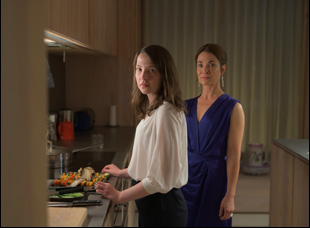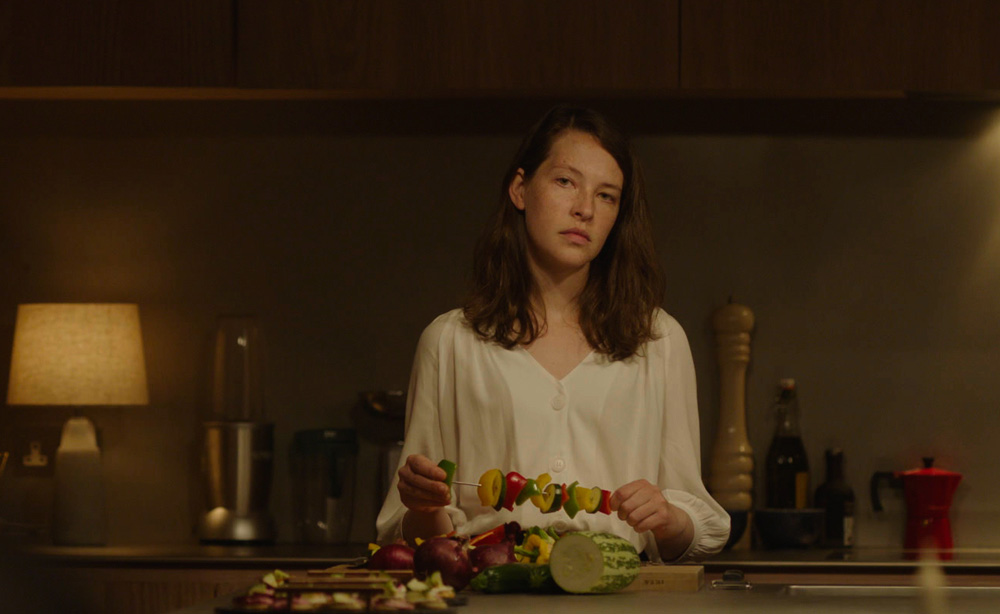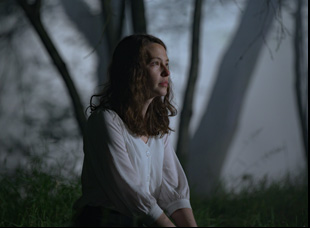“We’re a long way from home, but I sent directions,” Glenda (Nia Roberts) says with a bit of frustration as she welcomes Cadi (Annes Elwy) into her family’s country getaway in “The Feast.” Cadi isn’t there to enjoy the palatial estate, the marvels of a glass jewel box tucked in to emerald green pastures for as far as the eye can see lost on her as she’s been called in to assist with an important dinner party that Glenda is preparing for her husband Gwyn‘s business partner and has had to find her way at the last minute after another has bowed out. While Glenda is rather impervious to the help, Cadi can take comfort in how she isn’t all that warmer to her actual family that busies themselves before supper separately, with Gwyn excited for the opportunity to hunt for a rabbit that could be the centerpiece (though the grizzly business of skinning it will fall to Cadi), their older son Gweirydd (Sion Alun Davies) pedaling as fast as he can on his training bike, losing all sense of time as he gears up for a triathlon and the younger Guto (Steffan Cennydd) tries to mellow out, practicing his guitar and seemingly the only one without a care in the world.
That all changes pretty quickly once dinner is served in “The Feast,” an arrestingly nasty bit of business from Wales that is unique for many reasons, but chief among them is how it unfolds entirely in the Welsh language, which director Lee Haven Jones and writer Roger Williams cleverly deploy to speak to the legacy of inherited wealth that the family at its center comes from after pillaging the land for profit while the young servant that comes to the door would seem to be bringing the future along with her. “The Feast” opens with the sight of oil prospecting, but until Cadi arrives the family can keep at a distance from any aspect of the outside world, even the parts they’re directly responsible for shaping. As carrots are chopped and glasses are polished, another kind of preparation is taking place and Jones, who has sharpened his skills as a director on such shows as “Doctor Who” before making his feature debut, is able to connect the slick facade the family puts up with an elegant aesthetic that cuts deep as it begins to shatter.
After premiering earlier this year virtually at South by Southwest, “The Feast” became a breakout at Fantasia and Sitges and now arrives both theatrically and on demand in the U.S. and Jones spoke about how he found such a distinctive setting for the chilling thriller, defying potential cliches associated with either the genre or where the film takes place and being bold with the choices he made on set.
We wanted to make something that was singularly Welsh but also that could speak to a wider audience – it’s the three Ps in a way -a passion for horror and for Wales and and our stories here that we don’t see represented on film that often at all, it was pragmatism [because] horror has a massive audience throughout the world and is a great genre to deal with these pieces, and then a sense of politics in wanting to say something both about our history and about contemporary Wales, but also this looming climate crisis that we’re facing at the moment.
It’s such an amazing location you have. Was that actually in mind from the start?
It was actually because before the script was written [because] when Roger Williams, who wrote the script, and I were deciding what it was we wanted to make, we talked about what a stereotypical, cliched Welsh horror film might look like. Of course, Wales is a land of castles, so we thought it would be in an old stone building or a cottage and it would be very dark and dreary and very wet. What we tried to do is subvert that cliche and give the audience a kind of view of Wales with a modern, stark contemporary house that doesn’t feel Welsh at all, so it was written as a modern house and then we went to try and find the location. I was just doing some very early digging on the internet and found the house – ironically, it was called the Life House, given the death and destruction that occurs in it within our film. But I just loved it. I loved the Japanese aesthetic to the architecture that’s very stripped back. All along, I thought I hadn’t wanted to make your average British horror film, I wanted to make something that referenced Japanese horror and Korean horror and that was a bit more Skandy in its flavor. When I found this house, I thought, “This is a gift from the filmmaking gods.”
And you can’t underestimate the importance of luck within the filmmaking business. There it was in the landscape, influenced by Eastern culture in terms of the way it was built and the aesthetic of it, like a bunker as if it had landed from outer space, this hermetically sealed box amongst this barren natural landscape. It all just felt to me like a metaphor for the way the family failed to connect with each other and their surroundings and the world outside, so all of that was definitely there from very early on. Interestingly, Roger and I went back to the script and we adapted the script more to incorporate different features of the house, the fact that we do have these lovely, long corridors down which you can meander and a sense of tension builds as you’re following a character. Or even the cell that appears during the film that is incredibly eerie – that was built by the architect as a place for reflection. When I saw it, I was just absolutely taken with how horrific it was and we decided to incorporate that within our film, so we embraced everything that the house threw at us and you see that in the film.
When you’ve got a progression like this from day to night, but a limited schedule, are the scenes to ally getting crazier as you work through the day?
Because we wanted to subvert this cliche of what a horror film should look like, our film is not set in the winter, it’s set in the summer, a bit like “Midsommer,” but “Midsommer” wasn’t even out I think so Ari Aster stole my idea. [laughs] No, that’s not true. But people will tell you you can’t make a horror film in the summer, so we wanted to try and do that. What we ended up having to do was basically create a blackout around the house, so we shot interior nights during the day for a good nine days and then of course when we were shooting the exterior scenes, we had to wait until 11, 12, 1 o’clock in the morning. We did a series of very long nights, but it’s funny how the piece starts in a very naturalistic way and then as the lives of the characters are exposed and as they psychologically deteriorate, the structure of the piece deteriorates and it becomes less naturalistic and far more expressionistic and becomes theatrical. That journey is mirrored in terms of light. We start in the day and it literally becomes darker.

Particularly in the horror genre, sound is key. It’s one of the senses that we maybe forget about perhaps, particularly in television because we prioritize the visuals over the aural, sonic space, so it was definitely on my agenda and it’s part of the father’s journey. For example in the piece, he gets terrorized with sound and the sound of the drill that we first see in that scene and then of course [what happens later] is almost like the drill going into the ground, so the sound is very, very much part of that. And if you look at the first scenes, the opening half of the film has very hard sound cuts and hard visual cuts and then as the family dynamic implodes, the sound and the pictures become more layered. I’m fascinated by structure as much as I am by feeling, so all of those decisions have been made during the process.
It’s just such a confident first feature, and when you’re making choices about the long takes and the use of silence, it seems like you’re locked into decisions you can’t undo in the edit. Was there a point you knew you were on the right track?
Well, I’ve been directing television of nine years or so and one of my frustrations is that we have to shoot coverage. I think sometimes directors can become shot gatherers and are not making decisions and editorial decisions on the floor, and there’s a thrill to be had [there]. At first, I was terrified by the tyranny of freedom of making a film because it was literally me making decisions on the floor, but then I absolutely took to that because I’d been longing to do it. Yeah, there is a risk to it I guess, but I loved embracing that risk and making those decisions on the floor so you can’t get yourself out of trouble. It’s a discipline and it fed into the fact it was a relatively short shoot – 18 days – so some of those decisions had to be made and I often find that having a very disciplined structure helps the creative process. It’s not a hinderance. For example, my cinematographer and I would often set ourselves rules like alright, when does the camera move, how does the camera move or does the camera move [at all]? Once we set those rules, we will stick to them lavishly and a lot of people are slightly freaked out by that. We don’t really pan in the film at all – that was one of our rules and we stuck to it, but a lot of other directors I think are freaked out by being so prescriptive. I find it freeing. You have to have a structure in order to release the freedom strangely.
“The Feast” opens in theaters and on demand on November 19th.





